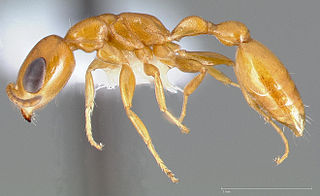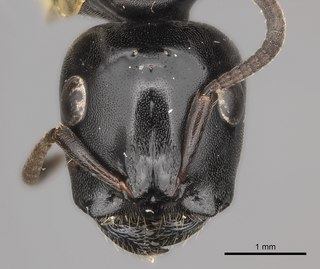 W
WPseudomyrmecinae is a small subfamily of ants containing only three genera of slender, large-eyed arboreal ants, predominantly tropical or subtropical in distribution. In the course of adapting to arboreal conditions, the pseudomyrmecines diversified and came to occupy and retain a much wider geographic range.
 W
WThe elongated twig ant, or Pseudomyrmex gracilis, is a large, slender species native to Mexico and arid parts of the US. The workers are about 7–12 millimeters (0.28–0.47 in) in length and generally wasp-like in appearance and style of movement. Worker ants are bi-colored; the head and gaster are dark, while the antennae, mouthparts, thorax and legs are dull orange with dark shading. They often may be seen on vegetation, foraging for live insects or collecting honeydew from sap-sucking insects.
 W
WMyrcidris is a genus of ant in the subfamily Pseudomyrmecinae containing a single species, Myrcidris epicharis. The genus is known only from a few localities north of Manaus, Brazil.
 W
WPseudomyrmecinae is a small subfamily of ants containing only three genera of slender, large-eyed arboreal ants, predominantly tropical or subtropical in distribution. In the course of adapting to arboreal conditions, the pseudomyrmecines diversified and came to occupy and retain a much wider geographic range.
 W
WPseudomyrmex is a genus of stinging, wasp-like ants in the subfamily Pseudomyrmecinae. They are large-eyed, slender ants, found mainly in tropical and subtropical regions of the New World.
 W
WPseudomyrmex apache is a species of ant in the family Formicidae.
 W
WPseudomyrmex cubaensis is a species of ant in the family Formicidae.
 W
WPseudomyrmex ejectus is a species of ant in the family Formicidae.
 W
WPseudomyrmex elongatus is a species of ant in the family Formicidae.
 W
WThe acacia ant is a species of ant of the genus Pseudomyrmex. These arboreal, wasp-like ants have an orange-brown body around 3 mm in length and very large eyes. The acacia ant is best known and named for living in symbiosis with the bullhorn acacia throughout Central America.
 W
WThe elongated twig ant, or Pseudomyrmex gracilis, is a large, slender species native to Mexico and arid parts of the US. The workers are about 7–12 millimeters (0.28–0.47 in) in length and generally wasp-like in appearance and style of movement. Worker ants are bi-colored; the head and gaster are dark, while the antennae, mouthparts, thorax and legs are dull orange with dark shading. They often may be seen on vegetation, foraging for live insects or collecting honeydew from sap-sucking insects.
 W
WPseudomyrmex leptosus is a species of ant in the genus Pseudomyrmex. It is endemic to certain regions in the United States.
 W
WPseudomyrmex pallidus is a species of ant found in the Nearctic realm with an extensive range throughout the southern United States to Central America.
 W
WPseudomyrmex seminole is a species of ant in the family Formicidae.
 W
WPseudomyrmex simplex is a species of ant in the family Formicidae.
 W
WPseudomyrmex spinicola is a species of red myrmecophyte-inhabiting neotropical ants which are found only in Nicaragua and Costa Rica. They live in the thorns of a tropical trees like Acacia collinsii or Acacia allenii, feeding on nectaries along with the protein and lipid-rich beltian bodies. These bodies are named for Thomas Belt, a naturalist who first described the interactions between acacias and ants in his 1874 book Naturalist in Nicaragua. Belt's book in fact described ants of this species, then unknown.
 W
WTetraponera is a genus of ants in the subfamily Pseudomyrmecinae that are commonly known as slender ants and are characterized by their arboreal nature and slender bodies. The 86 described species of Tetraponera all live in hollow structures of plants and trees, such as thorns or branches; these hosts are known as myrmecophytes. Tetraponera species are closely related to the New World genus of ants Pseudomyrmex, but differ in their relationships with host plants.
 W
WTetraponera aethiops is a species of ant in the subfamily Pseudomyrmecinae, which is native to tropical Africa. It is found living in the forest in association with Barteria fistulosa, a small tree.
 W
WTetraponera allaborans, is a species of ant of the subfamily Myrmicinae, which can be found in many Asian countries.
 W
WTetraponera nigra, is a species of ant of the subfamily Myrmicinae, which can be found in Borneo, Philippines, Bangladesh, India, Sri Lanka, Thailand, China.
 W
WTetraponera rufonigra, is a species of ant belonging to the subfamily Pseudomyrmecinae. It is distributed across Asia, and Africa. Commonly called the Bi-coloured Arboreal ant, they are arboreal and build small nests which are excavated holes usually in dried parts of trees. They are active hunters and hunt small insects. They have a well developed sting and when stung can cause allergic reactions in human beings.